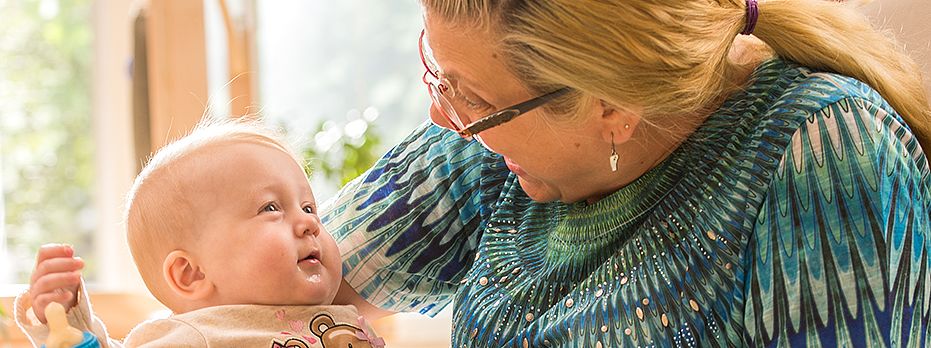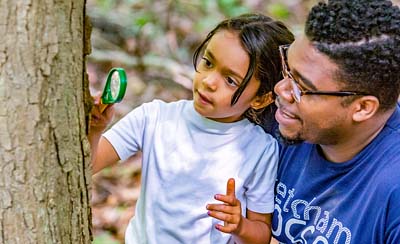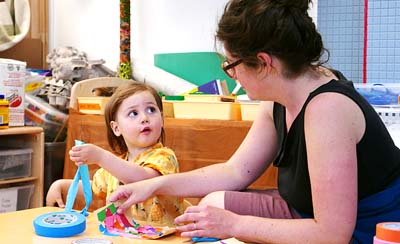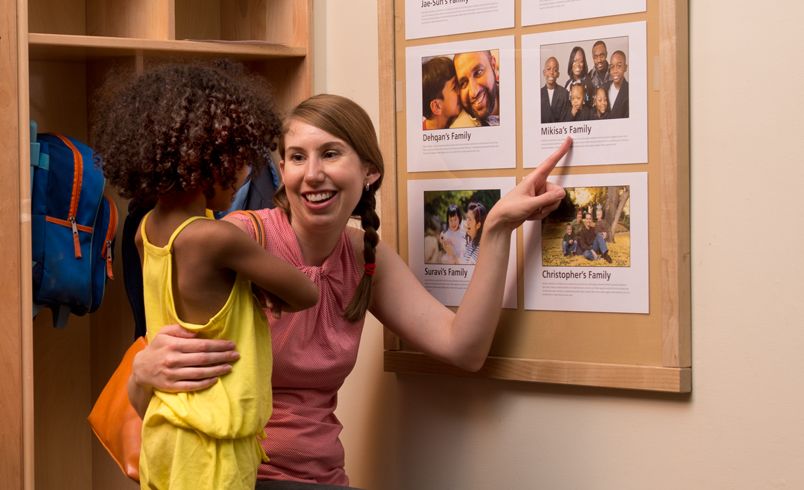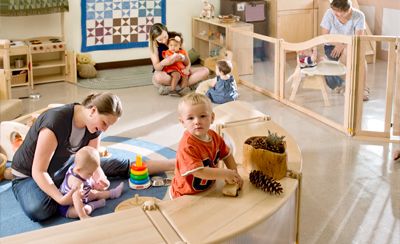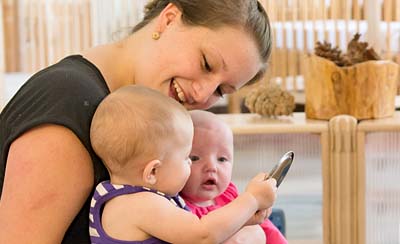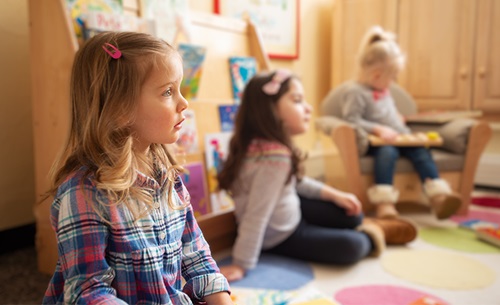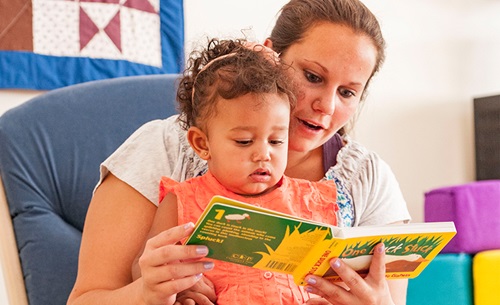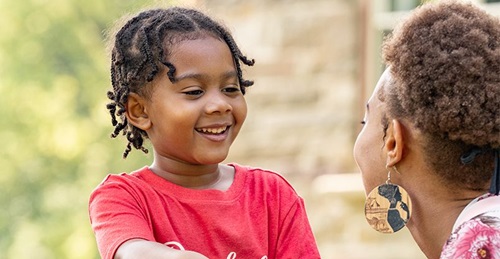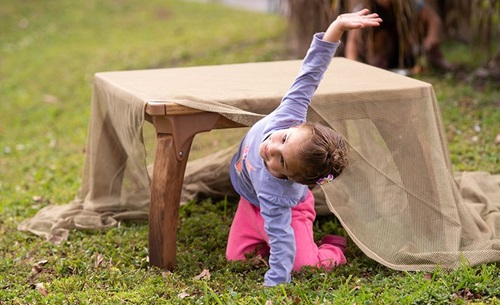Another Look at Relationship Continuity:
Strategies for Sustaining Relationships
| May 2019The importance of early relationships between children and the adults in their lives is well documented. “Starting at birth and continuing throughout life, our ability to thrive is affected by our ongoing relationships and experiences and the degree to which they are, supportive, and responsive, or not” (developingchild.harvard.edu). This article is designed to help the adults in early childhood programs for children from birth to age eight work towards creating healthy, supportive and responsive relationships through one crucial strategy—sustaining these relationships over time.
Relationship continuity is often viewed in terms of children staying in the same program or with the same adult over time. These strategies are primarily intended to facilitate dyadic relationship-building in the classroom setting (McMillion, M.B., 2018). This article approaches continuity from a more ecological perspective, examining ways that continuity might build or expand healthy, supportive, and responsive relationships between a child and his or her early childhood teachers. Then these strong relationships can serve as a springboard for supporting children and their families when inevitable changes do occur.
This article also explores ways that continuity of relationships between children and their caregivers may support children’s emerging self-regulation skills, while at the same time strengthen adult capabilities to succeed in their work environments (Center on the Developing Child at Harvard, 2013). When teaching adults are in relationship-based settings, these capabilities may allow them to manage the complexity of their work responsibilities with children, families, and peers in mutually helpful ways.
When children spend a long time with the same teachers, uninterrupted by external considerations such as birthdates or annual calendars, there can be many advantages. Time allows teachers to develop a deeper understanding of children’s temperaments, personalities, and emerging developmental skills. Further, when children spend their time with the same children, their teachers may begin to develop more nuanced understanding of what is happening developmentally and in peer relationships. This information allows early childhood teachers to individualize their interactions, curricula, and teaching practices. It also creates opportunities for individual and collegial reflective practices to emerge and mature. Strategies such as increased observation as a tool for figuring out the source of challenges, collaborating with a coworker to identify potential solutions to classroom problems, developing responsive curriculum to address individual children’s interests or development, and improving classroom environments to accommodate individual differences are examples.
The three-year-olds in Ms. Tanya’s class are in the middle of their morning block of center time. Suddenly, voices begin rising in the dramatic play area. Ms. Tanya hurries over and finds Malcolm and Olivia pulling on opposite ends of Malcolm’s special blanket from home. Malcolm, obviously distraught, shrieks, “It’s MINE!!!” Olivia says, “I had it first! It’s my cape! Give it back!” Ms. Tanya knows that the blanket is very special to Malcolm—he has had it since he was a baby in her infant/toddler classroom. He usually leaves it at home these days, but his mom is traveling for work and he needed a little extra reminder of home to feel better this week.
To Malcolm, she says, “This is your special blanket. I think you want to keep it safe. Let’s find a place in your cubby to store it so you can find it when you need it. I will help you take it there right now.” To Olivia, she says, “This is Malcolm’s special blanket—it is not for sharing. I can help you find another blanket that you can use for a cape instead.” Olivia is still very upset, and says, “No! I don’t want a cape!” As Ms. Tanya and the children are working on this problem, Jolie, one of Olivia’s classmates for the last two years, arrives in the dramatic play area and starts digging through the dress-up box. Pulling out a blanket that is close in color to Malcolm’s special blanket, she says, “Here, Olivia—I found your favorite blanket to be a cape! And here is the hat—it matches. I can be the green guy, like last time.” Olivia brightens up at her friend’s suggestion and reaches for the new blanket. Ms. Tanya says, “Thank you for your idea, Jolie! You remembered Olivia’s game from last time. I think she is ready to play with you again!” Ms. Tanya then makes a note to herself to remember how Jolie’s solution worked and try it with other children when another situation where contested possession of a toy occurs.
Parents, teachers, and program directors know that even when relationship continuity is prioritized, changes may still occur. However, long-standing classroom relationships can help to ease the transition for everyone. For example, children who are new to the group can join in with children who are already skilled at being together. Or, transitions from one classroom to another can happen in small groups instead of individually, allowing familiar friends to support each other in a new setting as they get to know their new teachers and classmates.
There are other ways to maintain relationship continuity in childcare programs when change is required. When a program’s needs require changes in classroom composition or location, teachers might rotate classroom materials and supplies as needed and repurpose, add, or remove furniture and equipment as necessary, instead of moving children to a different room. Alternatively, children and their teachers can simply move together to the next classroom, shortening the adjustment period required when children change teachers, peers, and classrooms all at once. Most importantly, this creative approach can prevent children from having to separate from familiar classmates with whom they have already developed relationships. It honors that social skills take time to emerge and offers children stability during times of transition.
Sometimes it is inevitable for children to move on from a beloved teacher. During these times, relationship continuity is still vitally important. Maintaining strong relationships with previous teachers can help children settle in more easily with their new teachers. It can be hard for children to lose a favorite teacher who knows just how to rub their backs at nap or remembers how interested they are in building very tall structures! These connections don’t have to disappear with new classroom and teacher assignments. Providing time for the experienced adult to share what she knows about the child moving into a new class is a good start. Shared outdoor play times are another great opportunity allow familiar friends to reconnect, favorite teachers to see how things are going, and expand the relationship between the familiar teacher and the new teacher. Those adult relationships have the potential to open the door for collaboration about adjustment strategies to try when unexpected challenges emerge, along with many other opportunities to learn from each other.
Lastly, it is important to remember children have connections to the physical space they inhabit, too. Many benefit from opportunities to visit a classroom left behind, even when there are new inhabitants. Visits might be to see the adults left behind, but they might also be an opportunity to share experiences, such as snack time or story time with former classmates or new children who have joined the group. Such visits can be spontaneous or planned and often work well at times of the day when open-ended activities are offered.
Early childhood teachers know how important relationships they have with parents and other family members are. What children learn from watching those relationships between adults can serve as an early introduction to how adults relate to each other in the wider social world, and why that matters. The way to build strong relationships between families and teachers is highly individualized and takes time to create and sustain. No matter what these relationship-building strategies look like, they have the potential to be beneficial for all involved (Center on the Developing Child at Harvard, 2017).
It is the end of the day and a few parents are gathered in Ms. Tanya’s classroom, chatting while their children get ready to go home. Denise shares that she has been having challenges with her four-year-old son Michael at bedtime lately. Getting him to go to bed and stay in bed is taking a long time, and they are both feeling tired and frustrated. Joseph, whose daughter has been in Michael’s class since they were toddlers, shares that they were having similar problems, but that turning off the TV and starting bedtime routines earlier had really helped. Janice, the parent of another long-time classmate, chimes in, wondering if Michael might be having nightmares like her son did. She says reading children books about bad dreams had made him feel better and that he was sleeping all night in his room most nights now. Hearing the conversation, Ms. Tanya offers a couple of book suggestions from the class library. She also shares her observation that four-year-olds tend to have busy minds that can make it hard to wind down for rest. At their class rest time, she has had good luck with soothing music, low lighting, and reading a calming book aloud to children as they relax. As she gathers Michael’s things to head home, Denise thanks the other adults for their suggestions, and borrows a book from Ms. Tanya to try with their bedtime routine that night.
While arrival and departure times remain a natural time for families to get to know each other, other kinds of relationship-building activities have certainly changed over the last decade. Apps abound to keep teachers and family members connected digitally to what is happening in their child’s lives in early childhood settings and many “firsts” are recorded with a smart phone rather than a camera. Many programs even offer observation cameras to allow families to check in with their children during the day. There are so many options, so be sure that when you choose how to digitally interface with families, you consider how you can use those platforms to maximize connection and relationship-building.
The relationships between families in your program is also important to consider. Sometimes relationships among participating families is organic, as they share news from home or discoveries about their child’s learning profile in school, learn from each other during arrival and departure, or problem-solve together both in the early childhood setting and beyond. These strategies make expanding family relationship continuity easier to pursue.
That said, in some cases a focus on expanding relationships between families needs encouragement in the busy world of early childhood service delivery. When relationships between teachers and family members are encouraged and sustained, both will likely benefit. An interesting thing about many of these experiences is that there is already overlap between the participants! Parents are already meeting each other during their arrival and departure routines while their children do the same, and teachers are in the role of bridging these interactions and relationships. Even with our busy lives, this is a natural place to add intentional relationship-building steps.
There are other ways that can also build connection between families in your program. Parent/teacher meetings seem to be less popular and perhaps less frequent than in the past, in some case replaced by small group get-togethers to exchange ideas about children’s experiences, discuss developmental issues, clarify policies and procedures, or just chat about the challenges of family life. These can take place in early childhood settings, but there is growing popularity in holding gatherings where children can be visible or nearby, such as a park where children can play while families connect, or at family-friendly restaurants that address the need for both food and friendship.
The important relationships between teachers and families can be impacted by classroom changes common in early childhood programs. In many early childhood settings, relationships between teachers and children often model the elementary school approach, with children changing teachers annually at the end of the academic year. In other programs, early relationship continuity between children and teachers focuses on the first two years of a child’s life. Reasons for these changes are diverse and may depend on setting, location, resources, and other variables. No matter how classroom changes are addressed in your program, relationship continuity can still be pursued. However, it is important to remember that we are asking children, teachers, and parents to make frequent changes in these relationships, and in light of what we know about the importance of relationships for optimal development (National Council on the Developing Child, 2004), it seems that considering fewer changes of early childhood teachers across the children’s early childhood years might be worth considering to benefit both children and their families.
An often-forgotten dimension of continuity is sustaining the rich and rewarding relationships that develop between teachers who share space and time in the classroom. In the early childhood world, turnover is still 30% (Porter, 2012). There are many causes for the high turnover, often including external forces such as promotions of teaching colleagues to new positions within early childhood settings. It is also true that teachers leave one setting to try out different ones, add new skills and experiences to their resumes, and make changes when there isn’t goodness of fit between a teacher and his or her current teaching position.
While many early childhood programs have plans for the induction of new teachers, fewer consider the planful separations for departing teachers. Although maintaining relationships over time with teachers who have moved on can be challenging, it can also be benefit everyone involved. Before it happens is a perfect time to think about and support continuing relationships between those who stay and those who leave. Consider starting with a formal way to say goodbye to departing teachers that honors not only their departure and also honors the experiences and contributions they shared with colleagues, children, and families.
Every staff member who leaves your program takes a little bit with them wherever they go. When teachers’ transition to their next career move is celebrated rather than dreaded, when relationships in the current program are cherished, and when an effort to sustain those relationships is initiated, the teacher who is leaving is more likely to have with a warm view of the separation process and may be interested in continuing to be in touch with her former colleagues. Rituals such as goodbye meals, a going-away gift of photographs, and structured opportunities to share stories of both challenging and rewarding times, honors the valued work that has taken place between colleagues.
After a teacher leaves your program, make sure there are formal and informal ways to stay in touch. Use technology to create opportunities for continued engagement and sharing between teachers, particularly if it sustains meaningful work that was already going on in the classroom. You might set up Pinterest pages to share curriculum ideas, start a closed Facebook page for ongoing communication about curriculum development, or plan social activities to reconnect such as occasional shared birthday get-togethers. Perhaps the most meaningful way to support communication between teachers who have taken on new employment is to offer shared professional development opportunities. These could include reuniting at annual professional development conferences, hosting professional development speakers on hot topics of interest, and observation exchanges where teachers have release time to visit each other’s classrooms to see the similarities and differences between settings and to continue learning from each other.
After nearly eight years of working together, Ms. Tanya’s co-teacher, Ms. Sandra is leaving the school for an administrative position at another early childhood program. While everyone can see this is a great opportunity for Sandra, adults and children alike know how much she will be missed. In the week before Sandra leaves, her administrator adds some extra staffing in the classroom, freeing Sandra up at times during the day so she can finish up documentation on progress of the children who have been in her care for the last few years and provide support for the new teacher taking her place, who is overlapping with her in the classroom and getting to know the children. Her administrator is also more present in the classroom, checking in often to make sure the plan the team is implementing is going well and making modifications as needed.
Ms. Tanya leaves a memory book near the entry to the classroom, so children and adults can leave messages, photos, and mementos for Ms. Sandra to take with her when she leaves. At the end of her final week, the staff meets for a special celebratory dinner at a favorite restaurant, sharing memories and lessons learned from Sandra, gifting her the memory book, and making plans for her to continue her relationship with cherished colleagues through shared professional development experiences.
The administrator’s role in maintaining relationships is important. Noriko (2012) confirms that lack of support from administrators is one cause of turnover in early childhood classrooms. Perhaps the best place to start is to determine if any of the ideas mentioned might be welcomed. Administrators can explore in advance what a departing teacher and her colleagues want before the separation begins. Each teacher is likely to have a preference about how the transition will occur, but it is helpful if a structured, but flexible, plan is already in place. Collaboration to design the best possible way to move through change together is likely to uncover some wonderful and unique ideas about how to make it work for a particular departing teacher, and later serve as starting place for discussion when the next teacher submits a resignation.
Things an administrator might do to support a departing teacher include providing time and assistance to complete the work related to leaving, such as packing up personal items shared in the classroom, collecting curriculum resources that were developed, and completing record keeping requirements for children’s files and portfolios, among others. Taking these steps helps support the departing teacher, as well as teachers remaining in the program, during the time of transition, making it more likely that the relationships between them can be sustained. When there are predictable, yet flexible, plans for how departing staff will say goodbye to children and colleagues in both formal and informal settings, the experience can be supportive for those who are leaving and for those who will stay behind. Also consider how you might include families, perhaps by planning a brief gathering with staff and families as a part of the separation process, where you might give a meaningful symbolic gift from the school that highlights contributions made or a framed class photo. These are only examples – there are many healthy ways to say farewell when a teacher moves on. The important thing is that your program has a plan to do so.
Finally, it is important to recognize that all changes and transitions in early childhood settings have the potential to lead to some stress for children and their early childhood teachers. At the same time, it is also crucial that efforts to lower stress levels during changes and transitions be part of the planning and consideration for such events. It makes sense that children will experience less stress when the adults in their lives know them well enough to be able to modify their interactions, the environment, and facilitate interactions between children when times are stressful. It also makes sense that adult stress could be modulated by thoughtful plans for appropriate relationship continuity among colleagues who have grown to trust and appreciate each other (Center on the Developing Child at Harvard University, 2017).
Building Self-Regulations Skills in Children and Adult Capabilities—What Is the Connection?
Brain research has led to a greater understanding of the capabilities children are developing during the early years of life and that adults must have in order to help young children develop their own self-regulation skills. These adult capabilities include planning, focus, self-control, awareness, and flexibility. Adults need access to all of these self-regulation skills to be proactive and have goal directed behaviors as they interact with children, and as they move through the wider world.
It is easy to forget that adult brains are developing, too! The brain continues to strengthen the networks needed to use adult capabilities successfully and when there are many opportunities to practice using them. Experiences with continuity of relationships have the potential to make a difference to children, families, early childhood teachers, and administrators and result in less stressful, more satisfying work environments (Center on the Developing Child at Harvard, 2016).
References
Center on the Developing Child at Harvard University (2016). From Best Practices to Breakthrough Impacts: A Science-Based Approach to Building a More Promising Future for Young Children and Families. Retrieved from www.developingchild.harvard.edu.
Center on the Developing Child at Harvard University (2016). Building Core Capabilities for Life: The Science Behind the Skills Adults Need to Succeed in Parenting and in the Workplace.Retrieved fromwww.developingchild.harvard.edu
Center for the Developing Child at Harvard University. (2013). Executive Function in Adults: The Science of Adult Capabilities. Retrieved from https://developingchild.harvard.edu/science/deep-dives/adult-capabilities/
Center on the Developing Child at Harvard University. (n.d.). Features of Relationships That Can Help Us Redesign Policy and Practice. Retrieved from https://developingchild.harvard.edu/resources/three-early-childhood-development-principles-improve-child-family-outcomes/#responsive-relationships://
Center on the Developing Child at Harvard University. (2017). Three Principles to Improve Outcomes for Children and Families. Retrieved from https://developingchild.harvard.edu/resources/three-early-childhood-development-principles-improve-child-family-outcomes/
McMullen, M. (2018). The Many Benefits of Continuity of Care for Infants, Toddlers, and Families and Caregiving Staff, Young Children, 73(3), 38-43
Porter, N. (2012). High Turnover Among Early Childhood Educators in the United States. Child Research Net. Retrieved from https://www.childresearch.net/projects/ecec/2012_04.html
Shonkoff, J.P. (2013). Strengthening Adult Capacities to Improve Child Outcomes: A New. National Scientific Council on the Developing Child (2004). Young Children Develop in an Environment of Relationships.

